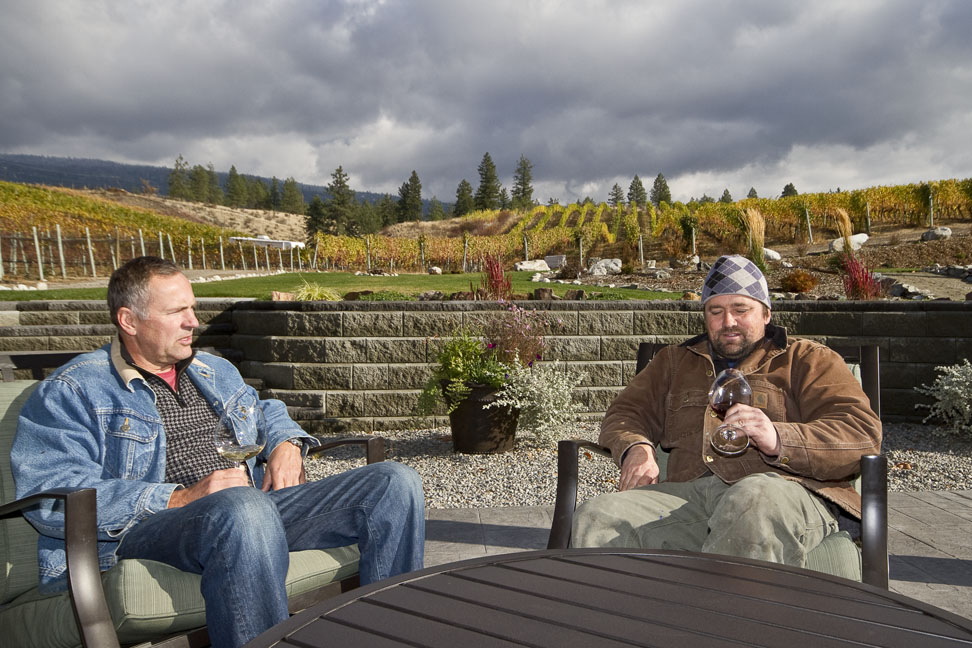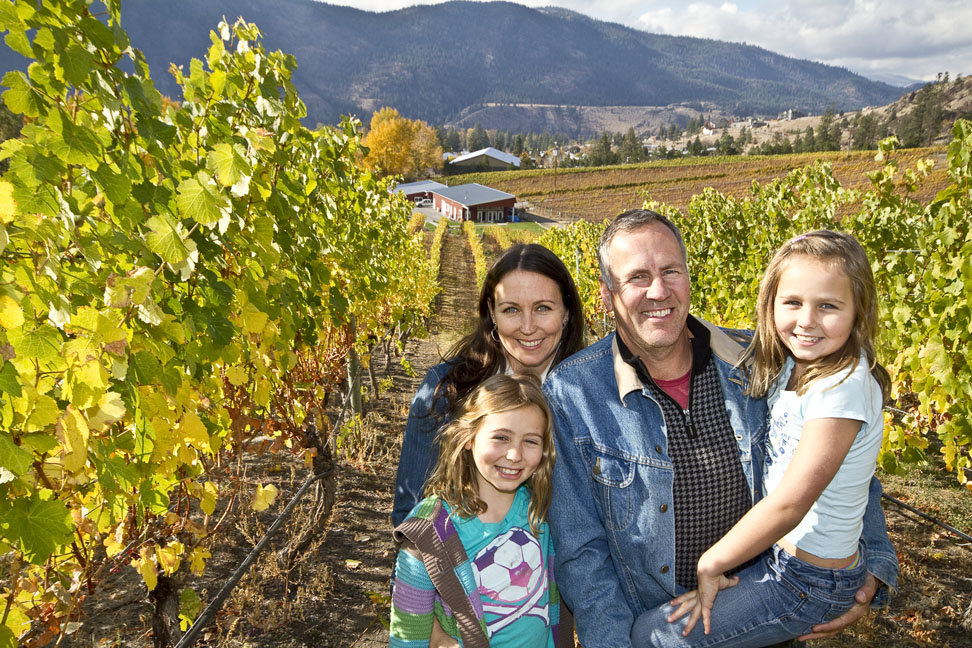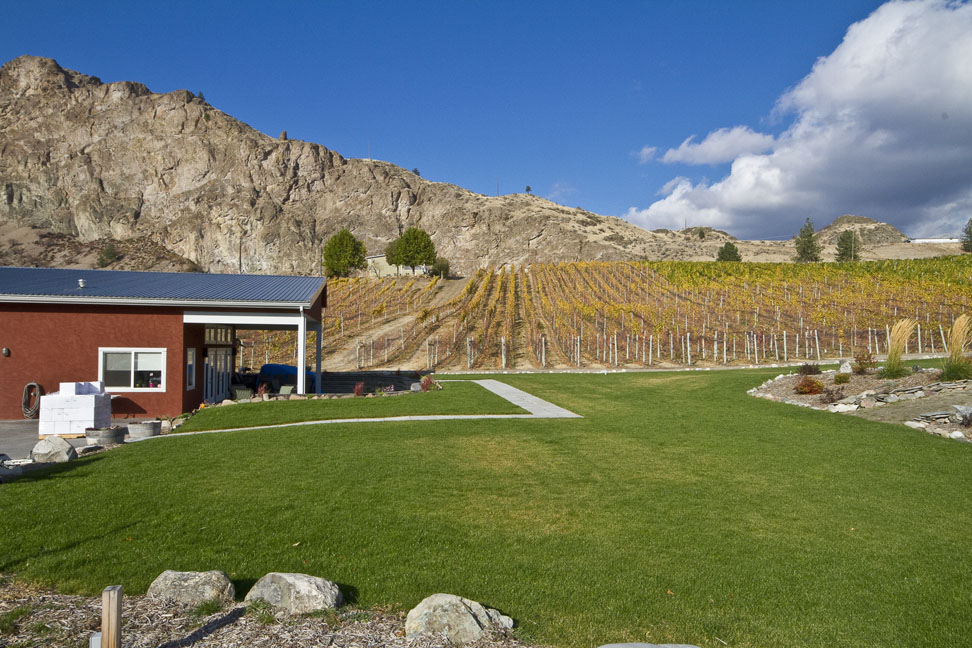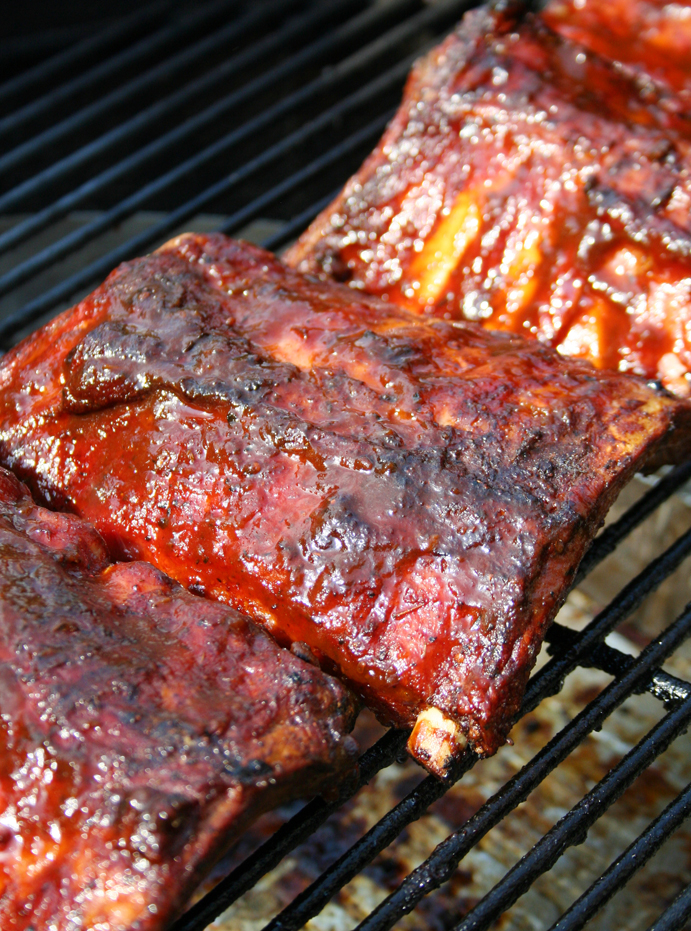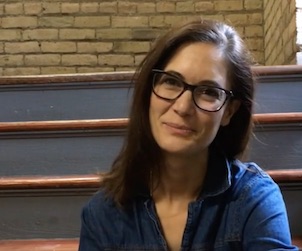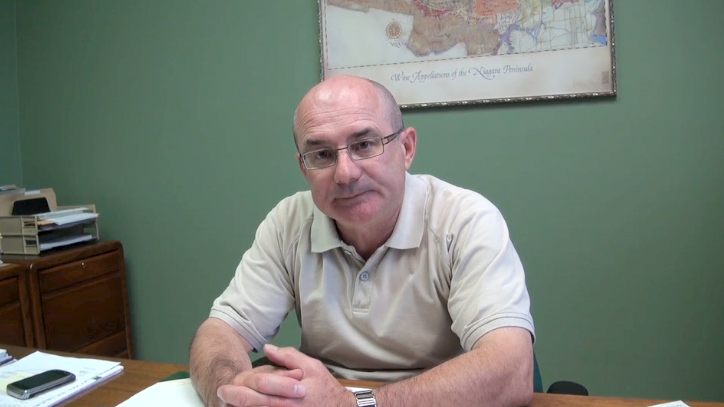Good Food Revolution: How would you describe the Meyer house style WITHOUT falling back on the same old cliches that wine sales and marketing departments come up with the world over?
Jak Meyer: My wife Janice and I decided to focus on varietals that we believe are best suited for the climate and the geography. Our belief that we should focus on cooler climate varietals like Chardonnay and Pinot Noir has served us well particularly in years like 2010 and 2011 where we had a very cool spring and harvest was very late in the year.. We are hoping to showcase BC fruit with a Burgundian influence being to make the wine in the vineyard through meticulous vineyard management practices and then minimal intervention in the wine making. Our goal is to have fresh crisp whites and bold flavorful reds with good acidity being key. Being small allows us to do everything by hand and manage the vineyard with precision creating great wines.
GFR: Most folks don’t immediately think of PInot Noir when they think of the Okanagan (Well, I certainly didn’t)… and yet you produce some truly stellar Pinots… why did you chose to go with that rather persnickety varietal?
JM: Pinot Noir although persnickety is truly rewarding when done properly. We wanted to stick with the noble varietals and not a big believer in lesser known varietals that may fall in or out of favour. Of the noble varietals again the Chardonnay and Pinot noir are the cooler climate varietals and let’s face it “WE ARE IN CANADA” it is cooler especially in the fall
GFR: Your Chardonnays are also anything but shabby… what makes your Chardonnay so different from so many others from the region?
JM: Firstly the style which is to pick earlier on before the acidity drops out where many prefer to pick based on higher sugar. Using only the best French oak barrels allowing for just the right amount of oak influence but not to overbear the fruit
GFR: I have read that you used to drink solely red wines… what wines did you drink back then, and then what opened your mind to the world of white wines?
JM: It has been a real learning curve for me. I suppose I started drinking reds mostly because the crowd I was with were big California Cab drinkers. As I developed a palate and taste for the Cabs, I thought I was an expert until one day drinking Penfold’s Grange and realizing I had been pretty one dimensional.
After that I went through an Old world period of Bordeaux’s and then a period of the big high alcohol Australian Shiraz. We had enlisted James Cluer and Rhys Pender (both Masters of Wine) as consultants to help develop our business plan and they pointed me towards Chardonnay, which at the time I was not the biggest fan of, but we wanted to go with Chardonnay as our belief that it would do well here. After drinking our own Chardonnay for a couple of years my taste changed and now has gone from primarily reds to primarily whites, in particular Chardonnay. I have a cellar with a huge amount of 16% alcohol Aussie Shiraz that I rarely touch anymore.
GFR: You also make a cracking Gewürztraminer that rates up there with my very favourite Canadian examples of that grape. Why did you choose to make wines from this varietal?
JM: When we purchased the property in Okanagan Falls it was a mature vineyard planted in 1994. However like many vineyards here in BC there is many small blocks of different varietals. We replaced Muscat, Gamay and Cab Franc with Pinot Noir so we could follow our plan. There was a 4 acre block of Gewurz that we thought would do well and wanted to try to emulate an Alsatian style of Gewurztraminer with typical Lychee flavors, good acidity and not to much sweetness. It is priced well and has been a very successful wine for us especially in the tasting room through the summer.
GFR: Your Winemaker, the Edmonton-born Chris Carson, learned his art in both Central Otago, California, and Burgundy… although I’m sure we can all agree that great wine is made in the vineyard, what do you believe he brings to your house’s wines?
JM: Chris is a very hard working dedicated wine maker. He is also in charge of the vineyard and when not in the winery is outside. It is his belief and he has certainly convinced us, that in order to make these great wines that he makes all of the decisions on vineyard management. His degree in both viticulture and wine making from Lincoln University in New Zealand and his international experience in some of the world’s greatest wine regions has given him the tools to make these fantastic wines
GFR: Your Okanagan Valley Pinot Noir is perhaps the best value Canadian Pinot I have ever tasted. How on earth does one capture so much of the essence of that tricky grape at such an accessible price point?
JM: Thank you! Our goal is to showcase what the Okanagan fruit is capable of. The Okanagan Valley is often a blend of our own vineyard as well as some purchased fruit from growers we have entered into agreements with strict criteria about how they manage the fruit. With land prices so high here it allows us to produce wines in the same manner as our higher single vineyard wines but at a value price. The amount of newer oak will be less and we will release the wines sometimes 6-12 months before the premium wines. All of this is a cost savings to us which we can pass onto the consumer and offer a great value wine
GFR: Every single New World Chardonnay/Pinot producer likes to litter his interviews with the B word (Burgundy)… why do you feel this is?
JM: Because Burgundy is the Holy Grail of Pinot and Chard. It is also a style being minimal intervention in the winemaking and such a long glorious history that who wouldn’t want to try and emulate this area. I do feel though that we are often now saying that our Pinots may be more of a Central Otago style as we feel these are some of the world’s great Pinots and the geography and climate is much more similar to the Okanagan
GFR: Do you not feel that the time has come to speak about Niagara, Okanagan, or Prince Edward County Chardonnays and Pinots without constantly using the B word?
JM: Yes I think we need to establish our own identity. It is OK to use the B word but it should be we are making BC or Ontario wines with traditional Burgundy philosophies but our fruit and region should be distinctive
GFR: You speak of utilising the “best winemakeing practices”… are organic or biodynamic viticulture and winemaking viable options in your part of the world?
JM: It is difficult we do follow these practices as much as possible but we also feel that you must do what is right for the vineyard when it is unhealthy. We use organic and biodynamic options whenever available first.
GFR: Why do you choose the closures that you do?
JM: This is an interesting battle which I am slowly losing. We have made all of our value line of wines using screw caps which are much less expensive and according to all data just as good as cork. Originally all of our wines we used Diam corks which are natural cork shredded and then put through a process to eliminate the bacteria that causes corked wines. The cork is then re-amalgamated using a food grade glue and is said to be 100% guaranteed no corked wines. I have been very happy with these closures however they say males over 50 all prefer cork. Chris being early forties and coming from Central Otago is continuously pushing me to go 100% screw cap. We will be going to screw cap on all of our wines except the Pinots for 2012 and depending on the feedback may go 100% in 2013.
GFR: What are your thoughts about putting quality wines in keg for by-the-glass restaurant pours?
JM: We think this is a very interesting idea and have kegged 3 different wines now. It is an interesting concept but not for the reasons that most people think. The cost savings to a producer is really negligible what this is really about is the environmental issues associated with it. the amount of fuel burned shipping glass, the amount of glass going into landfills etc is huge. The kegged wines have a serious impact on eliminating this. The restaurant can offer premium wines by the glass and not have to worry about waste or an opened bottle going bad and wasting the wine. The consumer can have a selection of premium wines by the glass always fresh. It is a business that makes sense but most people think it is cheap wine and the price should be less which is not the case
GFR: Do you have the opportunity to taste many Chardonnays and Pinots from other regions in Canada? Have any really stuck out?
JM: I am always sampling other wines to compare and have been very impressed with the Ontario chardonnay’s. We were invited to the International Cool Climate Chardonnay event in Ontario and met and tasted many of the regions wines. Ontario is doing a great job of marketing single varietals with a goal to international recognition. I am trying to start a fledgling BC Pinot Noir celebration September 1st including wineries with a focus on Pinot such as Howling Bluff, Blue Mountain, Tantalus, Quails Gate, Carson wine (our winemaker’s first vintage of his own Pinot) and a few others
GFR: Is there any chance that we’ll be seeing any more of your wines in the Ontario market?
JM: I hope so we have a special order listing that can only be ordered online via LCBO for our 2010 Reimer Vineyard Pinot Noir. I have submitted wines for listing in the vintages stores but not successfully so far. Our OK Valley Chard is in for submission right now which John Szabo recently gave 90 points. We have given a significant discount in order to get the wines on the shelves at a reasonable price but it still comes in a little higher than our retail price after the big markups into Ontario. Ontario wineries have the same problem getting their wines on the shelves here in BC. I hope that one day both Ontario and BC liquor boards will offer the same incentives for all Canadian wines rather than just in their own province allowing consumers the ability to get a true Canadian selection for everyone. It does not look promising and so probably won’t be happening anytime soon!
 Edinburgh-born/Toronto-based Sommelier, consultant, writer, judge, and educator Jamie Drummond is the Director of Programs/Editor of Good Food Revolution… And he was extremely impressed with these wines.
Edinburgh-born/Toronto-based Sommelier, consultant, writer, judge, and educator Jamie Drummond is the Director of Programs/Editor of Good Food Revolution… And he was extremely impressed with these wines.

